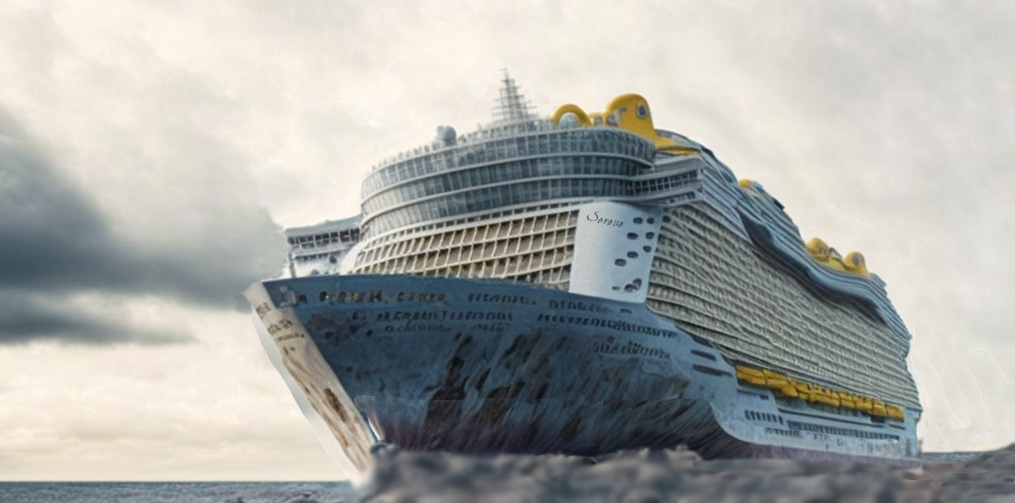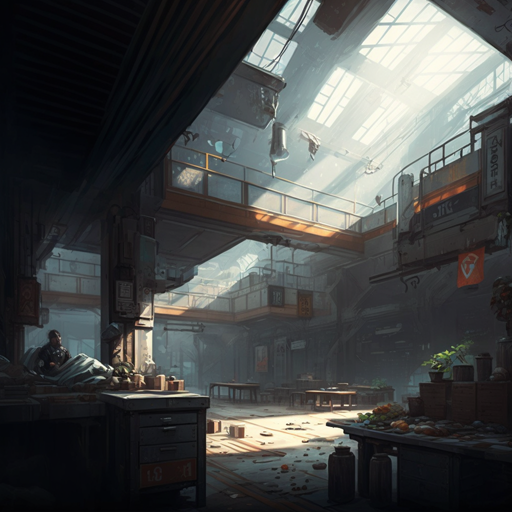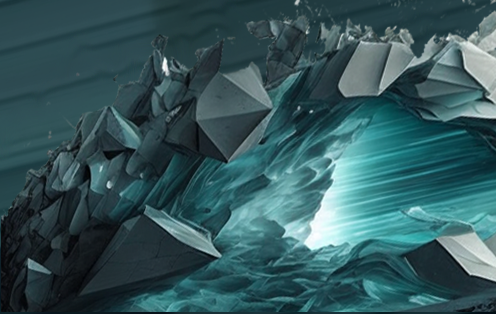Serene, the Stranded Ship
Serene is the is the massive ship stranded into the southen coast of The Peninsula. Due to its massive size, resiliance and almost perfect conservation state, it's asumed the ship is a ruin from one of the old worlds. A floating city, probably build to navigate the apparently infinite Eastern Sea
Description
The ship measures 350m in length and approximately 70m in width. Its main access point sits 2m above the ground, connected by sturdy ramps that link the streets below to the interior of the ship. This bustling level is known as the ground level, where most of the activities take place.
In total, the ship boasts 16 levels, but only the first 3 and the top 2 are utilized, while the remaining 11 levels remain mostly empty due to their challenging accessibility.
The ship's exterior, constructed as a single piece from an unfathomable material, has proven impervious to perforation or significant modification. Windows and balconies, seamlessly integrated into the hull, serve as distinctive features. However, these elements cannot be altered as they are a seamless part of the enigmatic metal that comprises the ship.
With this in mind, when beholding the ocean side of the ship for the first time, a sense of awe washes over everyone as they witness the colossal rift in the lower level, causing the outer wall to protrude deep into the ship's interior.
The interior of the ship presents a stark contrast, designed with adaptability in mind. Every room and space can be effortlessly rearranged.
Purpose / Function
Ground level
This is the place where the modularity of the internal wall has been more intensively used. Many of them have been removed, leaving a huge space where most of the activity happens—a bustling open street market.
The only walls that remain are the ones creating divisions between lanes and enclosing areas for different shops. The central area, which originally spanned several levels (5 or 6, depending on who you ask), receives light from the upper levels, even where the ceiling doesn't directly open to the outside. A clever arrangement of mirrors and a well-designed distribution of light from the outside balconies bring illumination to the entire area.
To access the top level of the ship, there are large tubes of light distributed throughout the vessel. These tubes, approximately 3 meters in diameter, serve as pathways. Stepping into one of them will transport you directly to the top levels, or if you step from above, to the ground level.
There are no other built-in methods to reach the many levels in between. Therefore, in several spots, nets, ropes, and both permanent and foldable ladders dangle from the upper levels. These makeshift ladders provide the most common means of reaching any level other than the top one.
Below level
The section is inmidiatly below the ground level. This area internal layer is smaller than the one above, due to the impresive rip in the sea side of the ship. This is where the port proper, with its many different sections to store, prepare and distribute the content of the ships arriving or leaving. Because of this most of the space is outside, which is perfect for the actual port activities. which plently of spaces for storage.
This section possesses several peculiarities. The first, and highly practical, is that it is the only level with multiple ramps connecting it to the ground level. These ramps also descend one more level, although it is uncommon for people to venture there.
In this second level, the other peculiarity becomes apparent. The ship's wall seamlessly transitions into an exotic type of crystal or rock, seemingly emerging from within the ship itself. While standing in these areas, one can hear strange noises, and many sailors recount tales of witnessing people vanish into the very rock that appears to have consumed the ship
Above levels
This area, referred to as "Above Levels," encompasses two to three levels above the ground level. It predominantly serves as a residential space within the ship. However, not all areas within these levels are utilized. The inhabited sections are primarily those that receive natural daylight, such as the spaces featuring balconies on the outside and those positioned around the central area overlooking the market.
Accessing these levels becomes progressively more challenging the higher one wishes to go. In addition to the nets that dangle down to the ground level, access to these levels can also be achieved from the outside using a similar setup of nets, ropes, and both permanent and foldable ladders. These improvised means of ascent provide an alternative method for reaching the residential levels from the external areas of the ship.
Intermidate levels
The intermediate levels of the ship, situated between the lower residential levels and the uppermost sections, are predominantly abandoned and left unused. Due to their challenging accessibility, these levels have become secluded areas where individuals can easily disappear or be concealed from sight. Rumors persist of illicit activities occurring within these levels, adding to their aura of mystery and intrigue. However, precise details about the nature of these activities remain largely speculative, shrouding the intermediate levels in a veil of secrecy.
Top levels
The most industrious levels of the ship are characterized by several areas where the roof is transparent, creating solariums. These spaces are primarily utilized for salt mining, water purification, and soap manufacturing.
In the solarium areas, seawater is brought in and placed within the solariums, allowing it to evaporate and condense on a net-like structure implemented in the roof. The resulting purified water is then collected and distributed throughout the rest of the ship. The salt extracted from the pool is removed, and the process can begin anew.
Initially, these areas were also used for farming purposes when people first arrived. However, over time, the majority of farming activities have been relocated outside of the ship.
Alterations
Almost all the alterations to the ship exterior are additions to either facilitate people or goods access to the ship.
Dry side
In the side which faces the city, there are two kind of modifications:Wet side
The most technically complex modification in the ship are boths in the wet side. Those are:The two main ones, deliver the water, using a simple hand crank, the newest one still uses the crank but instead of being manual, is powered by a numenera convertor using sea rising and falling during the day.








Comments